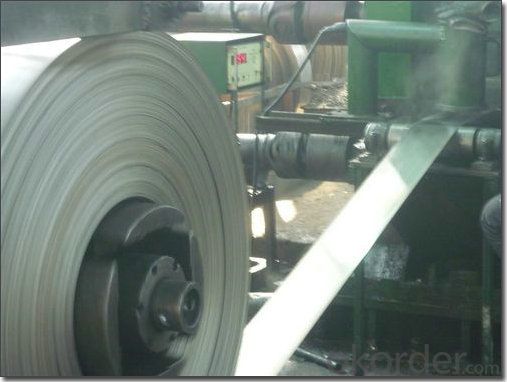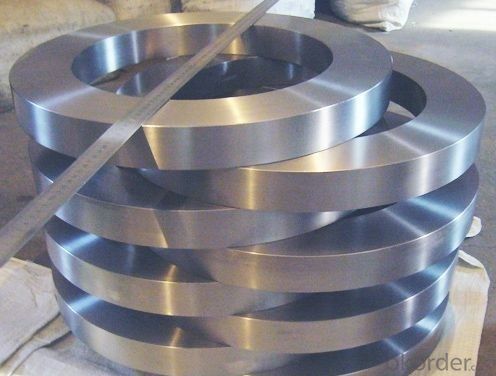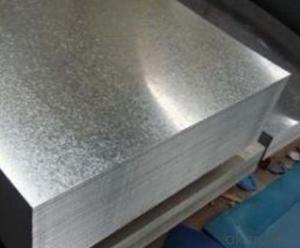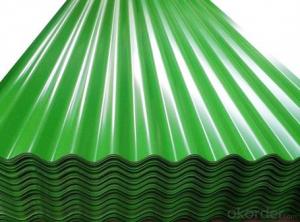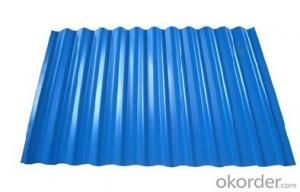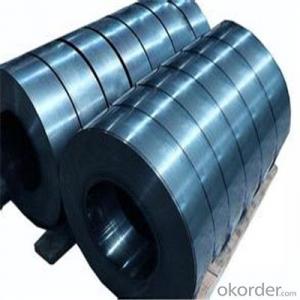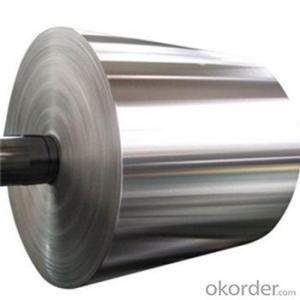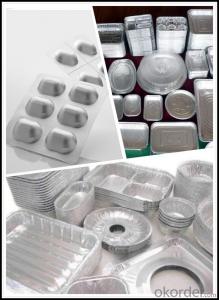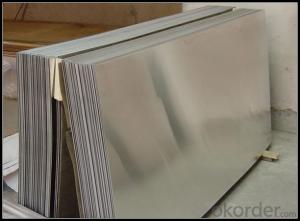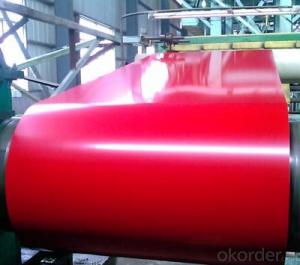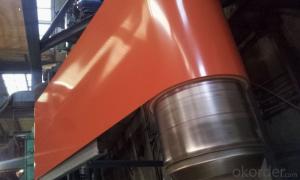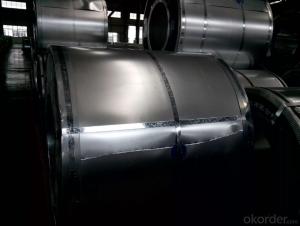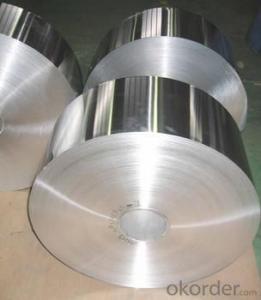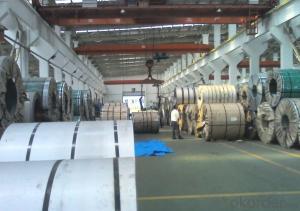Cold Rolled Steel Strip
- Loading Port:
- China Main Port
- Payment Terms:
- TT OR LC
- Min Order Qty:
- -
- Supply Capability:
- -
OKorder Service Pledge
OKorder Financial Service
You Might Also Like
Cold rolled stirps
Specification
Products: | |||
Item | Specification (mm) | ||
Diameter | Thickness | Length | |
Cold roll steel strip | 0.15mm-2.0mm | SIZE | |
Black CR steel strip | WIDTH:1000-2000mm Length:2000-6000mm | ||
Bright CR steel strip | |||
Detail information: | |||
Material | Q195,Q195L.Q235,SPCC,etc | ||
Standard | bright/dull/black finishe | ||
Thickness Tolerance | <>0.02 0.04 | ||
Certificate | SGS Certificate of meeded;the cost of inspection for buyer | ||
MOQ | 20T | ||
| Widely used in electronic production,Motorbike,Automobile,Stamping structure;Cold bent Sreel;Saw flake and etc;which is a good substitute for cold Roller and Cold plate in many field. | ||
Usage | |||
Production capacity | 15,000MT per month | ||
Packing | export standard packing | ||
delivery time | within 30 days after receipt of the advance payment or L/C | ||
delivery port | Tianjin xin'gang,china | ||
Main Market | Europe,America.Australia,Southeast | ||
Welcome every old and new customers to come to negotiate and telecommunicate with us. | |||
- Q: What are the categories of strip steel? How do you distinguish it?
- Steel is divided into two major categories: carbon steel (carbon steel) and alloy steel by chemical composition. Carbon steel is an alloy obtained by smelting pig iron. Besides iron and carbon, it also contains a small amount of impurities such as manganese, silicon, sulfur and phosphorus. Carbon steel has a certain mechanical properties, but also has good technical performance, and low prices. Therefore, carbon steels have been widely used. But with the rapid development of modern industry and science and technology, the performance of carbon steel has not fully meet the needs, so people have developed a variety of alloy steel. Alloy steel is a multicomponent alloy obtained by adding certain elements (called alloy elements) on the basis of carbon steel. Compared with carbon steel, the properties of alloy steel have been improved greatly, so it has been widely used.
- Q: How are steel strips used in the production of metal furniture?
- Steel strips are widely used in the production of metal furniture due to their versatile properties and durability. These strips are typically made from high-quality steel alloys and are available in various widths and thicknesses. In the manufacturing process, steel strips are typically cut to the desired length and then formed into the required shapes using bending, rolling, or stamping techniques. These strips serve as the primary structural component, providing strength and stability to the furniture piece. Steel strips are commonly used to create the frames, legs, and supports of metal furniture such as chairs, tables, shelving units, and cabinets. The strips are often welded or joined together to form a rigid structure that can withstand heavy loads and daily use. Additionally, steel strips can be used as decorative elements in metal furniture. They can be bent or formed into intricate patterns and designs, adding aesthetic appeal to the final product. These decorative strips can be attached to the furniture surface or used as accents to enhance its overall look. Furthermore, steel strips are known for their corrosion resistance, making them suitable for both indoor and outdoor applications. They can withstand exposure to moisture, humidity, and other environmental factors, ensuring the longevity of the metal furniture. In summary, steel strips play a crucial role in the production of metal furniture by providing structural support, durability, and decorative elements. Their versatility and strength make them an ideal choice for manufacturing high-quality and long-lasting furniture pieces.
- Q: What are the factors that affect the surface finish of steel strips?
- The surface finish of steel strips can be influenced by various factors. These factors encompass: 1. The chemical composition of the steel strip can play a significant role in determining its surface finish. Elements like carbon, silicon, and sulfur can impact the appearance and texture of the surface. 2. Prior to applying any finishing processes, it is crucial to properly prepare the surface of the steel strip. Factors such as cleaning, degreasing, and descaling can affect the overall finish of the strip. 3. The surface finish of the steel strip can be affected by the rolling process used during its manufacturing. Rolling temperature, speed, and pressure are among the factors that can influence the appearance and texture of the surface. 4. Lubricants are often utilized during the rolling process to decrease friction and prevent surface defects. The type and quantity of lubrication can impact the surface finish of the steel strip. 5. The microstructure of the steel strip can be altered through the annealing process, which in turn can affect its surface finish. Annealing temperature and time are factors that can influence the appearance and texture of the surface. 6. If the steel strip is coated or plated with another material, the quality and application of the coating or plating can influence the final surface finish. Factors like thickness, adhesion, and uniformity of the coating can impact the appearance and texture of the surface. 7. Improper handling or storage of the steel strip can result in surface damage or contamination. Scratches, dents, or exposure to corrosive substances are factors that can affect the overall surface finish. In conclusion, achieving the desired appearance and quality of steel strips requires careful consideration and control of a combination of these factors by manufacturers.
- Q: How are steel strips used in the production of metal fences?
- Steel strips are an essential component in the production of metal fences. These strips are typically made from high-quality steel that is durable and corrosion-resistant, making them ideal for outdoor applications. In the production process, steel strips are used to create the framework or skeleton of the metal fence. They are cut to the required dimensions and then shaped into various sections such as posts, rails, and pickets. This framework provides the structural integrity and support necessary for the fence to withstand external forces, such as wind or impact. Additionally, steel strips may be used to reinforce the connection points of the fence. They can be welded or bolted onto the framework to enhance stability and prevent any potential weak points. This reinforcement ensures that the fence remains sturdy and secure. Moreover, steel strips can also be used to enhance the aesthetics of the metal fence. They can be formed into decorative patterns or designs, adding a visually appealing element to the overall appearance of the fence. These strips may also be used as ornamental features on the top or between sections of the fence, further enhancing its beauty. Overall, steel strips play a crucial role in the production of metal fences. They provide the necessary strength, durability, and support required to create a sturdy and long-lasting fence. Additionally, they contribute to the visual appeal of the fence, making it an attractive choice for both residential and commercial applications.
- Q: How do steel strips respond to different forming processes?
- Steel strips respond differently to different forming processes depending on various factors such as the composition and properties of the steel, the type of forming process used, and the desired shape and characteristics of the final product. One common forming process for steel strips is cold rolling, where the steel strip is passed through a series of rollers to reduce its thickness and improve its surface finish. Cold rolling can increase the strength and hardness of the steel, making it more suitable for applications requiring high strength and durability. Additionally, cold rolling can also improve the dimensional accuracy and flatness of the steel strip. Another common forming process is hot rolling, where the steel strip is heated above its recrystallization temperature and passed through a series of rollers. Hot rolling can improve the formability of the steel strip, allowing it to be shaped into various complex forms. This process can also enhance the grain structure of the steel, resulting in improved mechanical properties. Steel strips can also be subjected to other forming processes such as bending, deep drawing, and stamping. Bending involves applying a force to the steel strip to deform it into a desired shape. Deep drawing is a process where a flat steel strip is formed into a three-dimensional shape, typically using a die and punch. Stamping is a process where a steel strip is pressed into a die to create intricate shapes and patterns. Overall, steel strips are versatile and can respond well to various forming processes. The specific response of a steel strip to a particular forming process will depend on factors such as the steel's composition, thickness, and the process parameters used. By selecting the appropriate forming process, manufacturers can achieve the desired shape, mechanical properties, and surface finish for the steel strip.
- Q: Are steel strips heat-treatable?
- Yes, steel strips are heat-treatable. Heat treatment is a process used to alter the properties of steel strips by subjecting them to controlled heating and cooling. This process can help enhance their strength, hardness, and other desired characteristics.
- Q: How do steel strips compare in terms of cost?
- Steel strips can vary in terms of cost depending on various factors such as the type of steel, dimensions, and quality. Generally, steel strips are considered to be cost-effective compared to other materials due to their durability, longevity, and wide availability in the market. However, specific pricing can only be determined by considering the specific requirements and market conditions.
- Q: How are steel strips used in the manufacturing of musical instruments?
- Musical instruments commonly incorporate steel strips for various purposes. An important use of steel strips lies in the creation of piano strings. Typically, these strings comprise high-quality steel wires that are tightly wound around a central steel strip. By lending stability and strength to the string, the steel strip enables it to produce clear and resonant notes when struck by the piano hammer. Steel strips also find application in the construction of specific percussion instruments like the vibraphone and marimba. These instruments utilize steel strips as resonating elements, commonly referred to as bars. The length, thickness, and shape of these steel bars determine the pitch and tone of the notes produced. They are typically mounted on a frame and struck with mallets to generate melodious sounds. Another use of steel strips in musical instruments lies in the production of guitar strings. Although the core of guitar strings is typically composed of steel wire, the winding around the core often incorporates a thin steel strip. This steel strip is coated with a layer of bronze or nickel and tightly wound around the core, providing durability, flexibility, and a distinctive tonal quality to the strings. In summary, steel strips play a vital role in the manufacturing of musical instruments, particularly in the production of piano strings, percussion instrument bars, and guitar strings. These strips contribute to the sound quality, durability, and playability of the instruments, empowering musicians to craft beautiful melodies and harmonies.
- Q: How are steel strips tested for fatigue strength?
- Steel strips are tested for fatigue strength through a process called fatigue testing. This involves subjecting the strips to repeated cyclic loading and unloading, simulating the stress and strain they would undergo during their intended use. The number of cycles required to cause failure is then measured, providing valuable information about the strip's fatigue resistance and durability.
- Q: How are steel strips used in the manufacturing of storage racks?
- Steel strips are commonly used in the manufacturing of storage racks as they provide strength, stability, and durability to the structure. These strips are often shaped and formed into various components, such as uprights, beams, and bracing, which are then assembled to create the frame of the storage rack. The steel strips also help to distribute the weight and load evenly across the rack, ensuring its stability and ability to hold heavy items.
Send your message to us
Cold Rolled Steel Strip
- Loading Port:
- China Main Port
- Payment Terms:
- TT OR LC
- Min Order Qty:
- -
- Supply Capability:
- -
OKorder Service Pledge
OKorder Financial Service
Similar products
Hot products
Hot Searches
Related keywords




